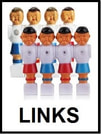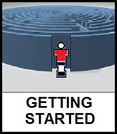Running a Foosball Class – Suggestions and Tips
1. Keep it Fun!
Not a problem, since quality foosball playing IS fun!
2. Plan for involvement
We recommend the minimum table / player ratio of (1) table / (5) players. If you have more students than this ratio recommends, we suggest always playing one of the ‘short’ games.
(see ‘Games and Activities’ below)
Inactive students create distractions. Keep it to a minimum.
However, waiting to get back onto the table ‘soon’ keeps students engaged in the action.
3. Teach and play by the Rules
We recommend the 'Rules – Simplified' available for downloading by clicking the link below.
Running a Foosball Class – Suggestions and Tips
1. Keep it Fun!
Not a problem, since quality foosball playing IS fun!
2. Plan for involvement
We recommend the minimum table / player ratio of (1) table / (5) players. If you have more students than this ratio recommends, we suggest always playing one of the ‘short’ games.
(see ‘Games and Activities’ below)
Inactive students create distractions. Keep it to a minimum.
However, waiting to get back onto the table ‘soon’ keeps students engaged in the action.
3. Teach and play by the Rules
We recommend the 'Rules – Simplified' available for downloading by clicking the link below.
| rules_simplified_a.pdf | |
| File Size: | 210 kb |
| File Type: | |
4. Courtesy Rules!
Model, and expect, courteous play from all players. This includes spectators giving players ample space and not leaning on the table or playing with score beads.
Always follow the ‘Ready’ Protocol!
Congratulate the winner.
During tournament matches, players should shake hands at the end of the match.
5. Develop Basic Skills - Establish a firm foundation.
We recommend stressing the following, even in the very first lesson:
1. Control
a.Passing and catching between the 5-bar and 3-bar. Pass, catch, pass, catch … etc.
b. Tic tacking between men on 3-bar, 5-bar, 2-bar.
Suggestion: Complete (10) passes ‘in a row’. If you mess up before completing (10), start over!
c. Wall & Lane passing. Teach the value of control, right from the start.
(Demonstrate the value of control over random shots from the 5-bar)
2. Develop at least one Shot
a. Kick Shot (both from ‘far side’ pull and ‘inner side’ push)
b. Push vs Pull - Practice both the push shot and pull shot on the 3-bar to see which feels more natural.
Practice - Set defense and shoot for the hole.
3. Defensive Basics
a. DON’T swing at rolling ball with defensive men. BLOCK the ball, then gain control.
(Demonstrate the result of swinging at a rolling ball with defense or goalie, and missing. It goes in the goal.)
b. Use defense and goalie as a unit of two, with about a ‘ball sized’ gap between men.
c. Always block the straight shot.
d. Consider some form of simple zone defense when opposing two-bar is shooting from the back.
e. Don’t clear or shoot the ball up the middle from defense.
f. Don’t shoot with the goalie.
6. Games and Activities
a. Free Play with games to 5 pts. This is a good time for you, the instructor, to get a feel for each players’ skill, attention to detail, competitiveness … etc, which can help inform your further instruction.
b. Singles or Doubles tournament. Best 2 out of 3, Double elimination works well, so that players get to stay ‘in’ even after they have lost one match.
NOTE: Many on-line bracket generators or forms are available. One simple one we use is:
https://www.printyourbrackets.com/double-elimination-tournament-brackets.html
c. Round Robin event. This way everyone gets to play everyone else. The benefit of a Round Robin, is that it can carry over from
meeting to meeting, even if not everyone is in attendance. Simply draw up the RR list and play until everyone has played
against all the other participants.
Use any number of long or short game formats for the Round Robin event.
Some RR generator sites are:
http://www.teamopolis.com/tools/round-robin-generator.aspx
http://challonge.com/tournament/bracket_generator
d. Short Game Ideas:
1. Single game to 7 points.
2. Play 5 balls only. This makes for a fun ‘short’ game. ONLY five balls are played, and the # of goals for each is recorded.
3. Games to 3 pts. This is a handy format when time is limited, and / or when player / table ratio is high.
Model, and expect, courteous play from all players. This includes spectators giving players ample space and not leaning on the table or playing with score beads.
Always follow the ‘Ready’ Protocol!
Congratulate the winner.
During tournament matches, players should shake hands at the end of the match.
5. Develop Basic Skills - Establish a firm foundation.
We recommend stressing the following, even in the very first lesson:
1. Control
a.Passing and catching between the 5-bar and 3-bar. Pass, catch, pass, catch … etc.
b. Tic tacking between men on 3-bar, 5-bar, 2-bar.
Suggestion: Complete (10) passes ‘in a row’. If you mess up before completing (10), start over!
c. Wall & Lane passing. Teach the value of control, right from the start.
(Demonstrate the value of control over random shots from the 5-bar)
2. Develop at least one Shot
a. Kick Shot (both from ‘far side’ pull and ‘inner side’ push)
b. Push vs Pull - Practice both the push shot and pull shot on the 3-bar to see which feels more natural.
Practice - Set defense and shoot for the hole.
3. Defensive Basics
a. DON’T swing at rolling ball with defensive men. BLOCK the ball, then gain control.
(Demonstrate the result of swinging at a rolling ball with defense or goalie, and missing. It goes in the goal.)
b. Use defense and goalie as a unit of two, with about a ‘ball sized’ gap between men.
c. Always block the straight shot.
d. Consider some form of simple zone defense when opposing two-bar is shooting from the back.
e. Don’t clear or shoot the ball up the middle from defense.
f. Don’t shoot with the goalie.
6. Games and Activities
a. Free Play with games to 5 pts. This is a good time for you, the instructor, to get a feel for each players’ skill, attention to detail, competitiveness … etc, which can help inform your further instruction.
b. Singles or Doubles tournament. Best 2 out of 3, Double elimination works well, so that players get to stay ‘in’ even after they have lost one match.
NOTE: Many on-line bracket generators or forms are available. One simple one we use is:
https://www.printyourbrackets.com/double-elimination-tournament-brackets.html
c. Round Robin event. This way everyone gets to play everyone else. The benefit of a Round Robin, is that it can carry over from
meeting to meeting, even if not everyone is in attendance. Simply draw up the RR list and play until everyone has played
against all the other participants.
Use any number of long or short game formats for the Round Robin event.
Some RR generator sites are:
http://www.teamopolis.com/tools/round-robin-generator.aspx
http://challonge.com/tournament/bracket_generator
d. Short Game Ideas:
1. Single game to 7 points.
2. Play 5 balls only. This makes for a fun ‘short’ game. ONLY five balls are played, and the # of goals for each is recorded.
3. Games to 3 pts. This is a handy format when time is limited, and / or when player / table ratio is high.





